Abstract
1. Using whole-cell patch-clamp techniques, we found that the voltage-dependent K+ conductance in human peripheral blood T lymphocytes is enhanced threefold at alkaline intracellular pH (pHi) compared to acid pHi. This pH dependence can be described by a model having two strongly co-operative proton binding sites with pka 7.15. A similar pHi sensitivity exists for K+ conductance in mitogen-activated cells. 2. The reversal potential, threshold voltage for activation of the K+ conductance, and voltage dependence of steady-state inactivation are not affected by pHi. Activation and inactivation kinetics are also unchanged. 3. Single-channel measurements made in whole-cell patch-clamp mode indicate that the effect of intracellular pH on the amplitudes of single-channel events parallels, but does not wholly account for, the effect of pHi on the macroscopic currents. 4. Lowering extracellular pH (pHo) shifts the threshold for activation of the K+ current to a more depolarized voltage, consistent with a surface charge screening effect. Apparent changes in peak current and activation kinetics at acid pHo can be accounted for by this voltage shift. An additional slowing of inactivation kinetics at low pHo does occur. 5. The relevance of the pH sensitivity of the voltage-gated K+ conductance to lymphocyte mitogenesis and volume regulation is discussed.
Full text
PDF

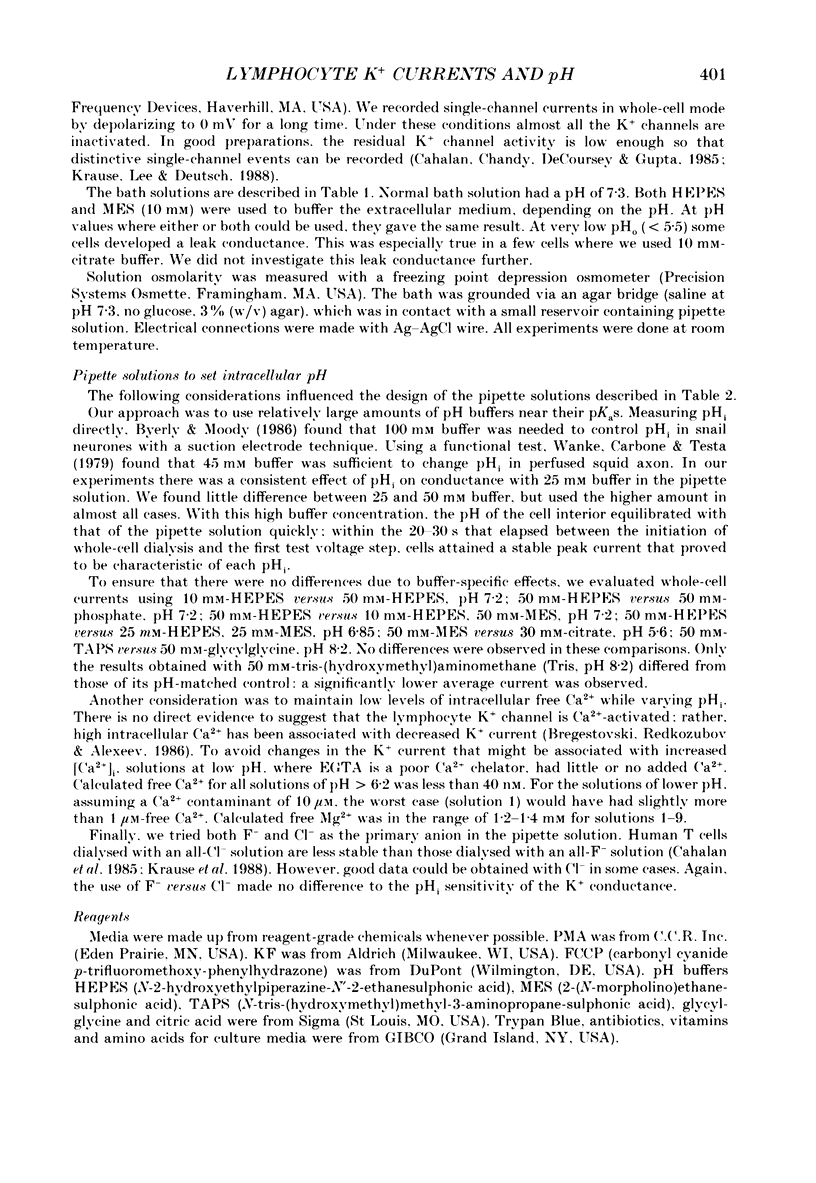
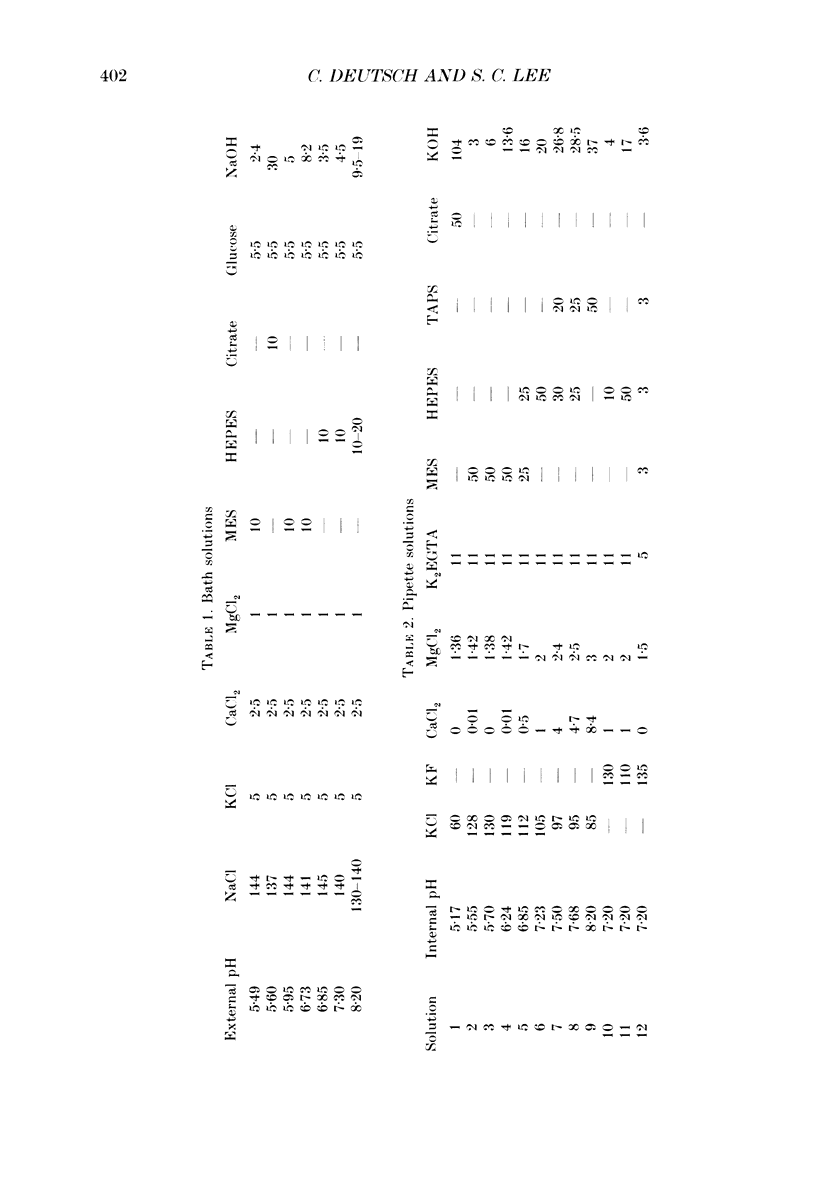

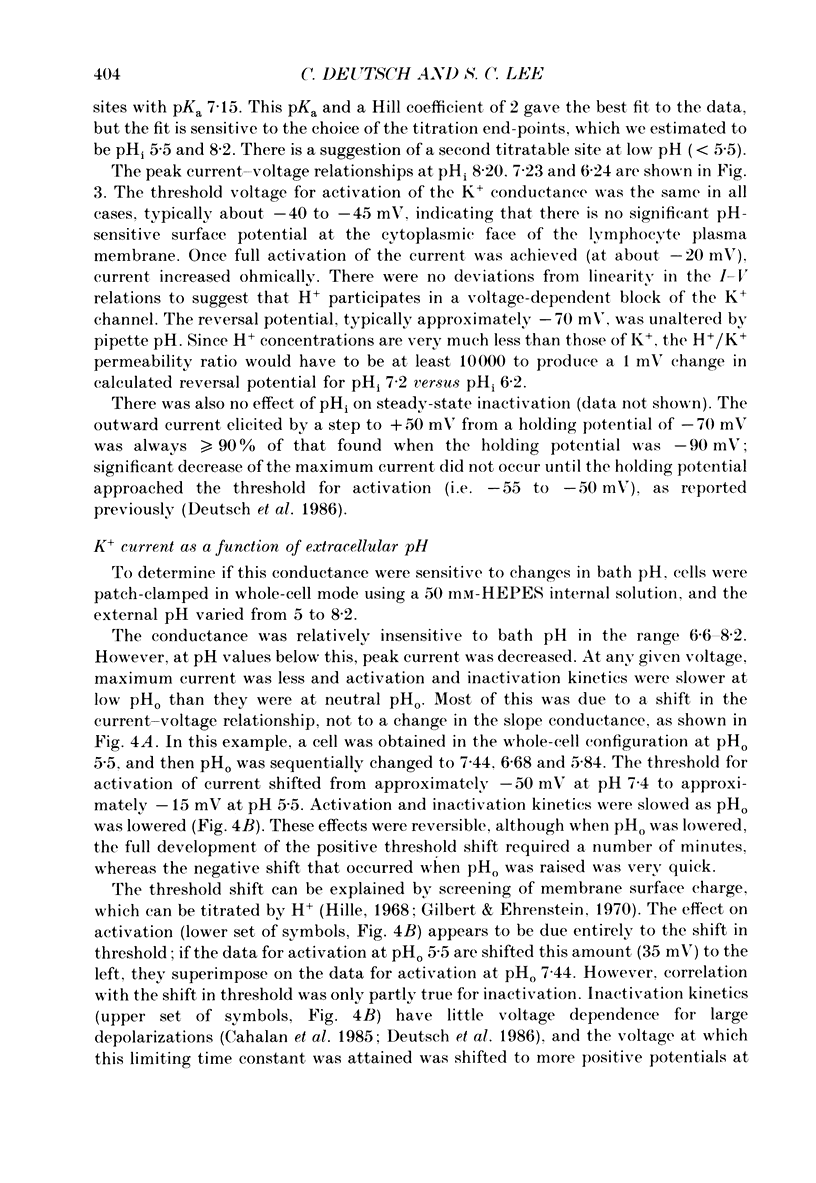
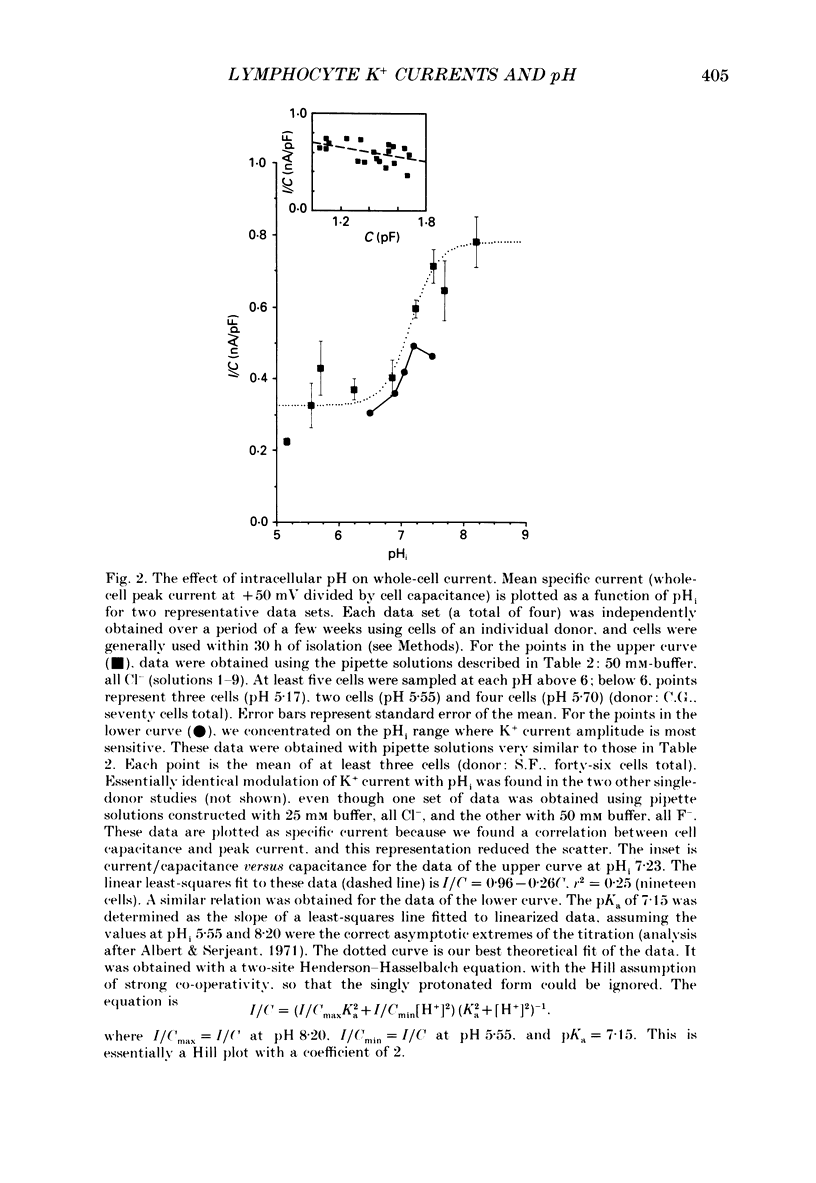

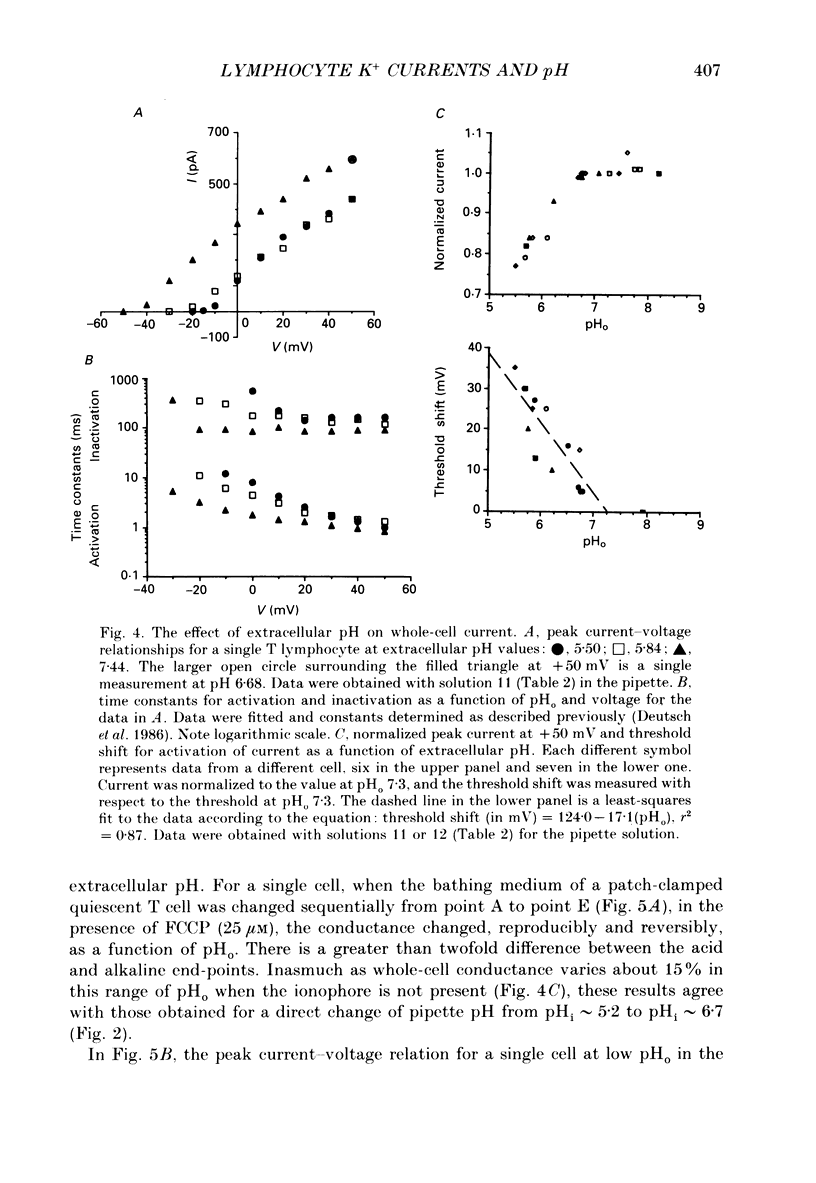
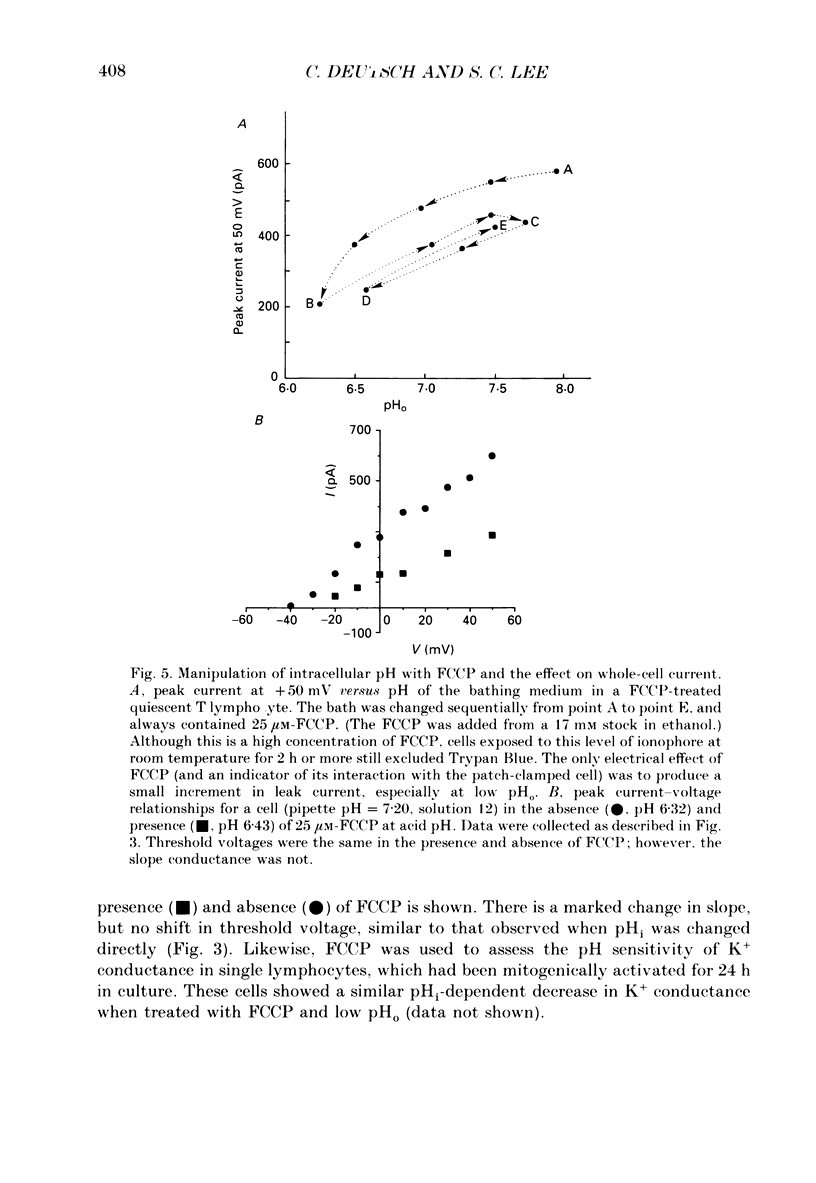
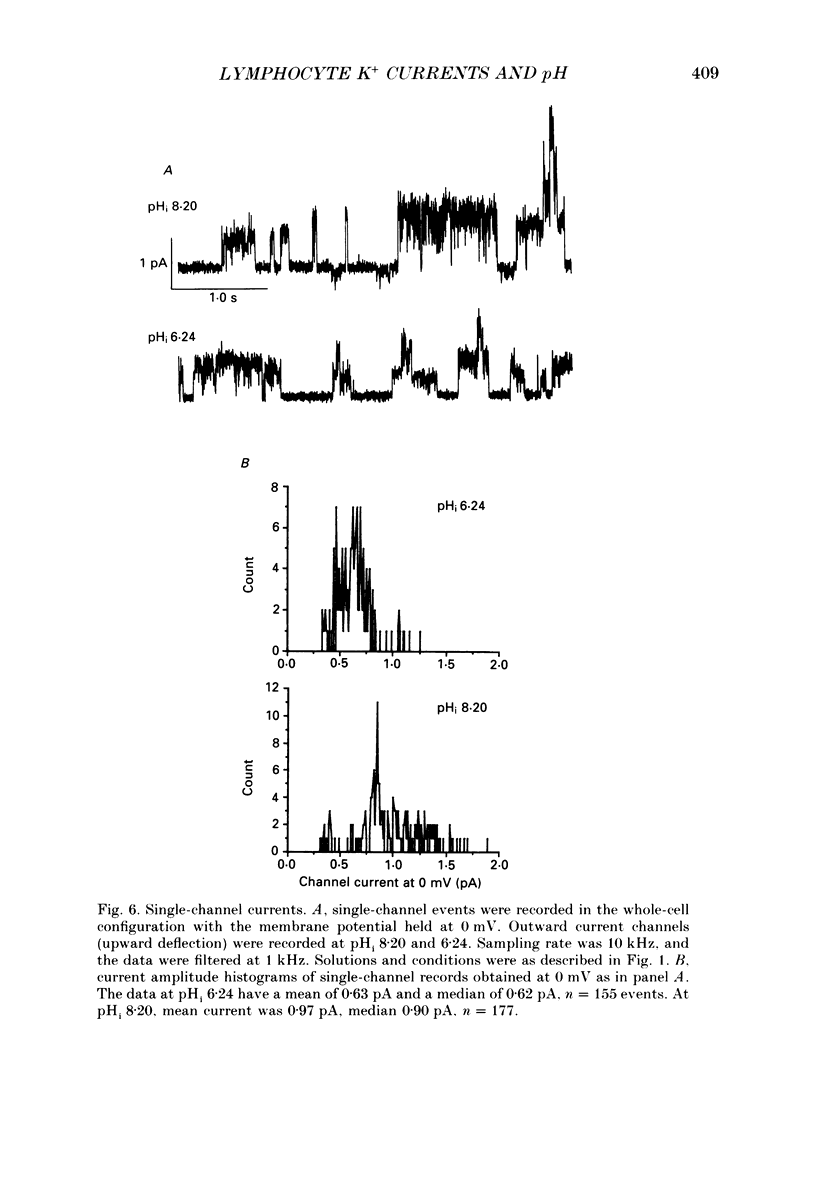
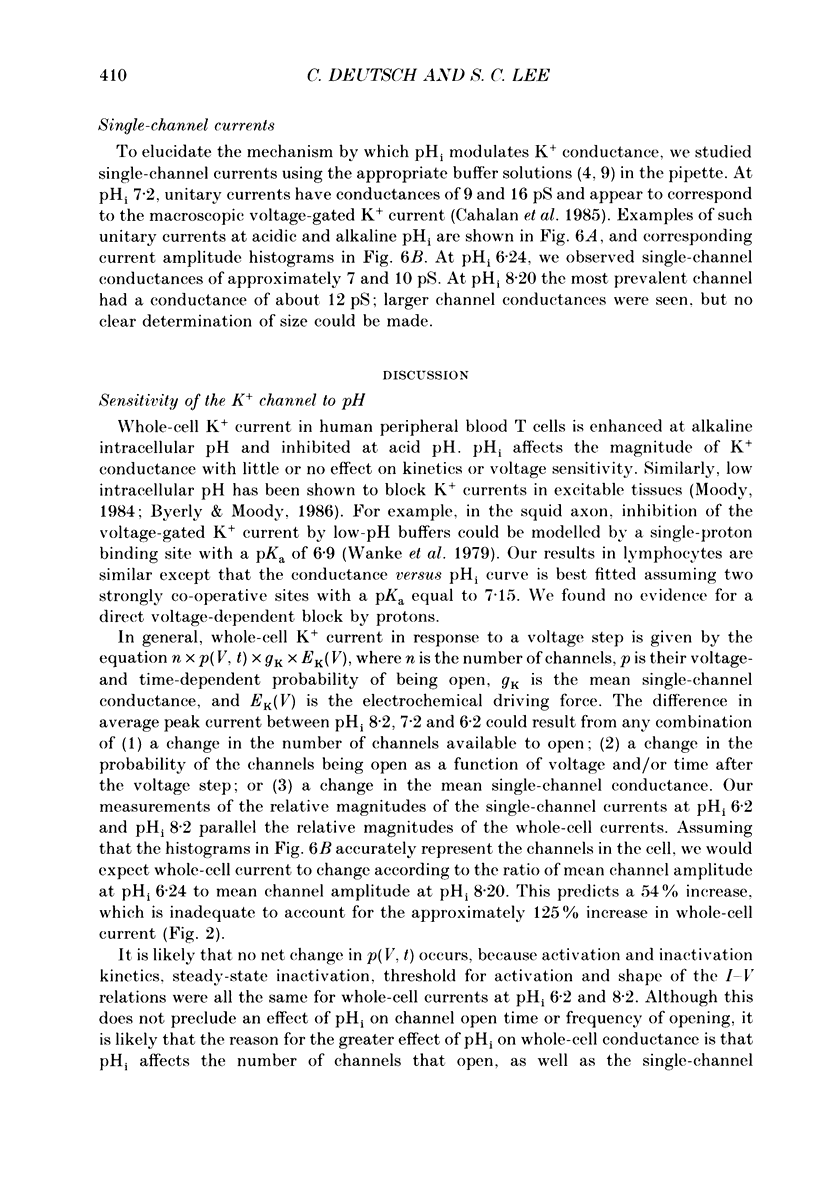
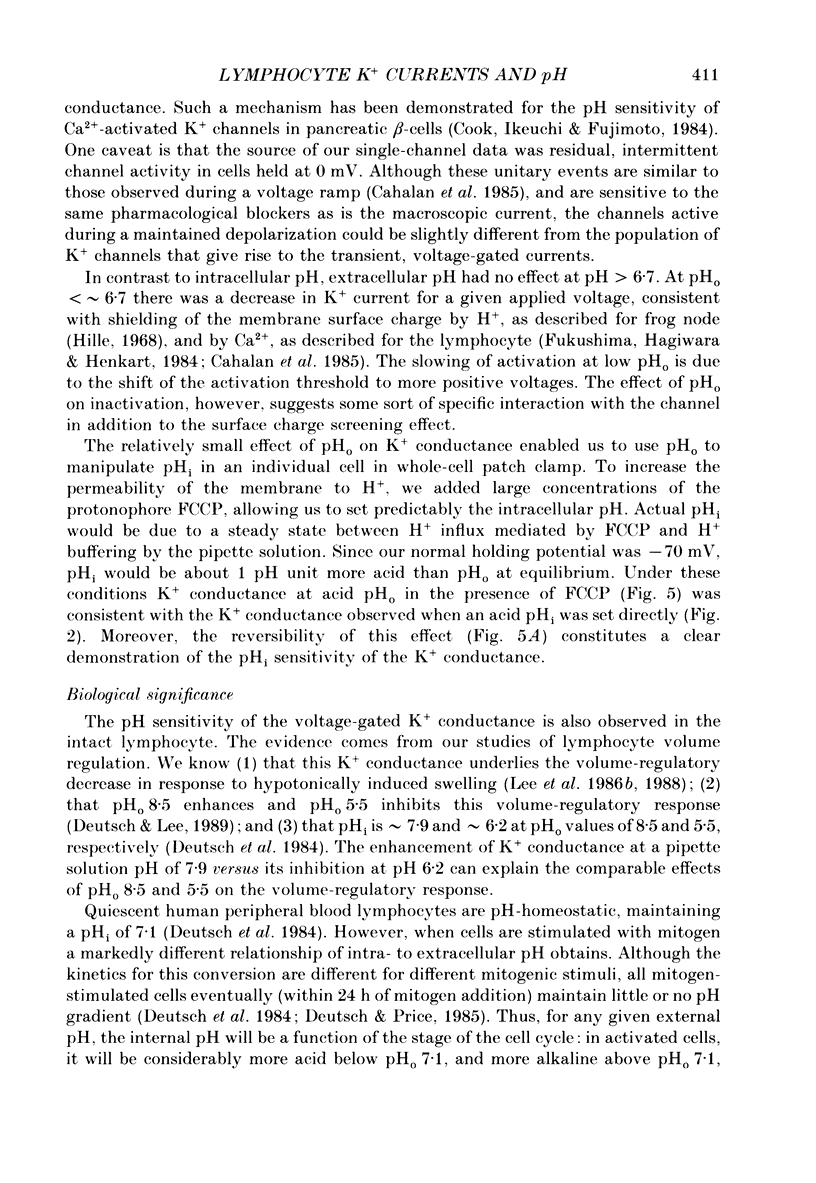

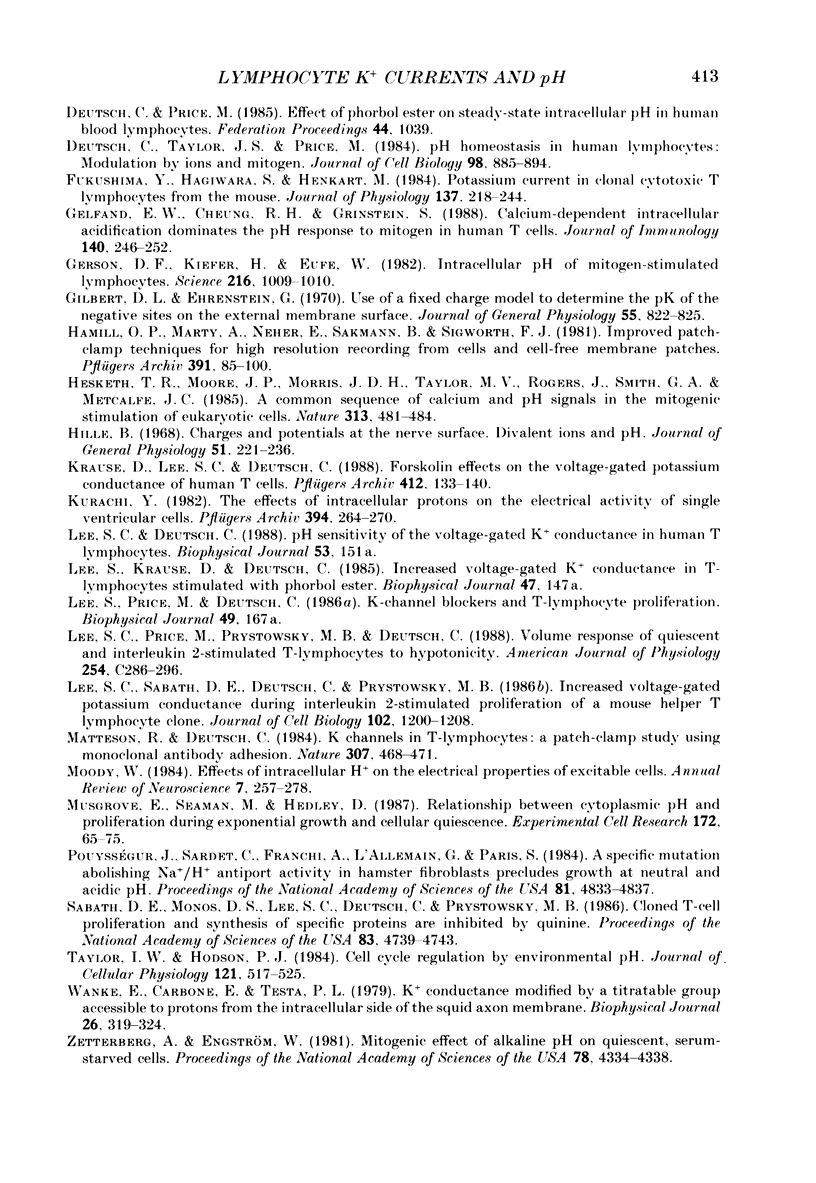
Selected References
These references are in PubMed. This may not be the complete list of references from this article.
- Bregestovski P., Redkozubov A., Alexeev A. Elevation of intracellular calcium reduces voltage-dependent potassium conductance in human T cells. 1986 Feb 27-Mar 5Nature. 319(6056):776–778. doi: 10.1038/319776a0. [DOI] [PubMed] [Google Scholar]
- Byerly L., Moody W. J. Membrane currents of internally perfused neurones of the snail, Lymnaea stagnalis, at low intracellular pH. J Physiol. 1986 Jul;376:477–491. doi: 10.1113/jphysiol.1986.sp016165. [DOI] [PMC free article] [PubMed] [Google Scholar]
- Cahalan M. D., Chandy K. G., DeCoursey T. E., Gupta S. A voltage-gated potassium channel in human T lymphocytes. J Physiol. 1985 Jan;358:197–237. doi: 10.1113/jphysiol.1985.sp015548. [DOI] [PMC free article] [PubMed] [Google Scholar]
- Chandy K. G., DeCoursey T. E., Cahalan M. D., McLaughlin C., Gupta S. Voltage-gated potassium channels are required for human T lymphocyte activation. J Exp Med. 1984 Aug 1;160(2):369–385. doi: 10.1084/jem.160.2.369. [DOI] [PMC free article] [PubMed] [Google Scholar]
- Cook D. L., Ikeuchi M., Fujimoto W. Y. Lowering of pHi inhibits Ca2+-activated K+ channels in pancreatic B-cells. Nature. 1984 Sep 20;311(5983):269–271. doi: 10.1038/311269a0. [DOI] [PubMed] [Google Scholar]
- Decoursey T. E., Chandy K. G., Gupta S., Cahalan M. D. Mitogen induction of ion channels in murine T lymphocytes. J Gen Physiol. 1987 Mar;89(3):405–420. doi: 10.1085/jgp.89.3.405. [DOI] [PMC free article] [PubMed] [Google Scholar]
- Deutsch C., Krause D., Lee S. C. Voltage-gated potassium conductance in human T lymphocytes stimulated with phorbol ester. J Physiol. 1986 Mar;372:405–423. doi: 10.1113/jphysiol.1986.sp016016. [DOI] [PMC free article] [PubMed] [Google Scholar]
- Deutsch C., Taylor J. S., Price M. pH homeostasis in human lymphocytes: modulation by ions and mitogen. J Cell Biol. 1984 Mar;98(3):885–893. doi: 10.1083/jcb.98.3.885. [DOI] [PMC free article] [PubMed] [Google Scholar]
- Gelfand E. W., Cheung R. K., Grinstein S. Calcium-dependent intracellular acidification dominates the pH response to mitogen in human T cells. J Immunol. 1988 Jan 1;140(1):246–252. [PubMed] [Google Scholar]
- Gerson D. F., Kiefer H., Eufe W. Intracellular pH of mitogen-stimulated lymphocytes. Science. 1982 May 28;216(4549):1009–1010. doi: 10.1126/science.6281887. [DOI] [PubMed] [Google Scholar]
- Gilbert D. L., Ehrenstein G. Use of a fixed charge model to determine the pK of the negative sites on the external membrane surface. J Gen Physiol. 1970 Jun;55(6):822–825. [PMC free article] [PubMed] [Google Scholar]
- Hamill O. P., Marty A., Neher E., Sakmann B., Sigworth F. J. Improved patch-clamp techniques for high-resolution current recording from cells and cell-free membrane patches. Pflugers Arch. 1981 Aug;391(2):85–100. doi: 10.1007/BF00656997. [DOI] [PubMed] [Google Scholar]
- Hesketh T. R., Moore J. P., Morris J. D., Taylor M. V., Rogers J., Smith G. A., Metcalfe J. C. A common sequence of calcium and pH signals in the mitogenic stimulation of eukaryotic cells. Nature. 1985 Feb 7;313(6002):481–484. doi: 10.1038/313481a0. [DOI] [PubMed] [Google Scholar]
- Hille B. Charges and potentials at the nerve surface. Divalent ions and pH. J Gen Physiol. 1968 Feb;51(2):221–236. doi: 10.1085/jgp.51.2.221. [DOI] [PMC free article] [PubMed] [Google Scholar]
- Krause D., Lee S. C., Deutsch C. Forskolin effects on the voltage-gated K+ conductance of human T cells. Pflugers Arch. 1988 Jul;412(1-2):133–140. doi: 10.1007/BF00583742. [DOI] [PubMed] [Google Scholar]
- Kurachi Y. The effects of intracellular protons on the electrical activity of single ventricular cells. Pflugers Arch. 1982 Sep;394(3):264–270. doi: 10.1007/BF00589102. [DOI] [PubMed] [Google Scholar]
- Lee S. C., Price M., Prystowsky M. B., Deutsch C. Volume response of quiescent and interleukin 2-stimulated T-lymphocytes to hypotonicity. Am J Physiol. 1988 Feb;254(2 Pt 1):C286–C296. doi: 10.1152/ajpcell.1988.254.2.C286. [DOI] [PubMed] [Google Scholar]
- Matteson D. R., Deutsch C. K channels in T lymphocytes: a patch clamp study using monoclonal antibody adhesion. Nature. 1984 Feb 2;307(5950):468–471. doi: 10.1038/307468a0. [DOI] [PubMed] [Google Scholar]
- Moody W., Jr Effects of intracellular H+ on the electrical properties of excitable cells. Annu Rev Neurosci. 1984;7:257–278. doi: 10.1146/annurev.ne.07.030184.001353. [DOI] [PubMed] [Google Scholar]
- Musgrove E., Seaman M., Hedley D. Relationship between cytoplasmic pH and proliferation during exponential growth and cellular quiescence. Exp Cell Res. 1987 Sep;172(1):65–75. doi: 10.1016/0014-4827(87)90093-0. [DOI] [PubMed] [Google Scholar]
- Pouysségur J., Sardet C., Franchi A., L'Allemain G., Paris S. A specific mutation abolishing Na+/H+ antiport activity in hamster fibroblasts precludes growth at neutral and acidic pH. Proc Natl Acad Sci U S A. 1984 Aug;81(15):4833–4837. doi: 10.1073/pnas.81.15.4833. [DOI] [PMC free article] [PubMed] [Google Scholar]
- Sabath D. E., Monos D. S., Lee S. C., Deutsch C., Prystowsky M. B. Cloned T-cell proliferation and synthesis of specific proteins are inhibited by quinine. Proc Natl Acad Sci U S A. 1986 Jul;83(13):4739–4743. doi: 10.1073/pnas.83.13.4739. [DOI] [PMC free article] [PubMed] [Google Scholar]
- Taylor I. W., Hodson P. J. Cell cycle regulation by environmental pH. J Cell Physiol. 1984 Dec;121(3):517–525. doi: 10.1002/jcp.1041210310. [DOI] [PubMed] [Google Scholar]
- Wanke E., Carbone E., Testa P. L. K+ conductance modified by a titratable group accessible to protons from the intracellular side of the squid axon membrane. Biophys J. 1979 May;26(2):319–324. doi: 10.1016/S0006-3495(79)85251-0. [DOI] [PMC free article] [PubMed] [Google Scholar]
- Zetterberg A., Engström W. Mitogenic effect of alkaline pH on quiescent, serum-starved cells. Proc Natl Acad Sci U S A. 1981 Jul;78(7):4334–4338. doi: 10.1073/pnas.78.7.4334. [DOI] [PMC free article] [PubMed] [Google Scholar]


